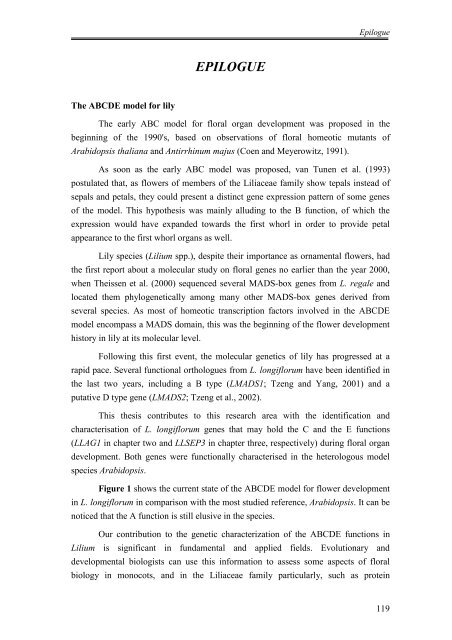Flower development of Lilium longiflorum - The Lilium information ...
Flower development of Lilium longiflorum - The Lilium information ...
Flower development of Lilium longiflorum - The Lilium information ...
Create successful ePaper yourself
Turn your PDF publications into a flip-book with our unique Google optimized e-Paper software.
<strong>The</strong> ABCDE model for lily<br />
EPILOGUE<br />
Epilogue<br />
<strong>The</strong> early ABC model for floral organ <strong>development</strong> was proposed in the<br />
beginning <strong>of</strong> the 1990's, based on observations <strong>of</strong> floral homeotic mutants <strong>of</strong><br />
Arabidopsis thaliana and Antirrhinum majus (Coen and Meyerowitz, 1991).<br />
As soon as the early ABC model was proposed, van Tunen et al. (1993)<br />
postulated that, as flowers <strong>of</strong> members <strong>of</strong> the Liliaceae family show tepals instead <strong>of</strong><br />
sepals and petals, they could present a distinct gene expression pattern <strong>of</strong> some genes<br />
<strong>of</strong> the model. This hypothesis was mainly alluding to the B function, <strong>of</strong> which the<br />
expression would have expanded towards the first whorl in order to provide petal<br />
appearance to the first whorl organs as well.<br />
Lily species (<strong>Lilium</strong> spp.), despite their importance as ornamental flowers, had<br />
the first report about a molecular study on floral genes no earlier than the year 2000,<br />
when <strong>The</strong>issen et al. (2000) sequenced several MADS-box genes from L. regale and<br />
located them phylogenetically among many other MADS-box genes derived from<br />
several species. As most <strong>of</strong> homeotic transcription factors involved in the ABCDE<br />
model encompass a MADS domain, this was the beginning <strong>of</strong> the flower <strong>development</strong><br />
history in lily at its molecular level.<br />
Following this first event, the molecular genetics <strong>of</strong> lily has progressed at a<br />
rapid pace. Several functional orthologues from L. <strong>longiflorum</strong> have been identified in<br />
the last two years, including a B type (LMADS1; Tzeng and Yang, 2001) and a<br />
putative D type gene (LMADS2; Tzeng et al., 2002).<br />
This thesis contributes to this research area with the identification and<br />
characterisation <strong>of</strong> L. <strong>longiflorum</strong> genes that may hold the C and the E functions<br />
(LLAG1 in chapter two and LLSEP3 in chapter three, respectively) during floral organ<br />
<strong>development</strong>. Both genes were functionally characterised in the heterologous model<br />
species Arabidopsis.<br />
Figure 1 shows the current state <strong>of</strong> the ABCDE model for flower <strong>development</strong><br />
in L. <strong>longiflorum</strong> in comparison with the most studied reference, Arabidopsis. It can be<br />
noticed that the A function is still elusive in the species.<br />
Our contribution to the genetic characterization <strong>of</strong> the ABCDE functions in<br />
<strong>Lilium</strong> is significant in fundamental and applied fields. Evolutionary and<br />
<strong>development</strong>al biologists can use this <strong>information</strong> to assess some aspects <strong>of</strong> floral<br />
biology in monocots, and in the Liliaceae family particularly, such as protein<br />
119














